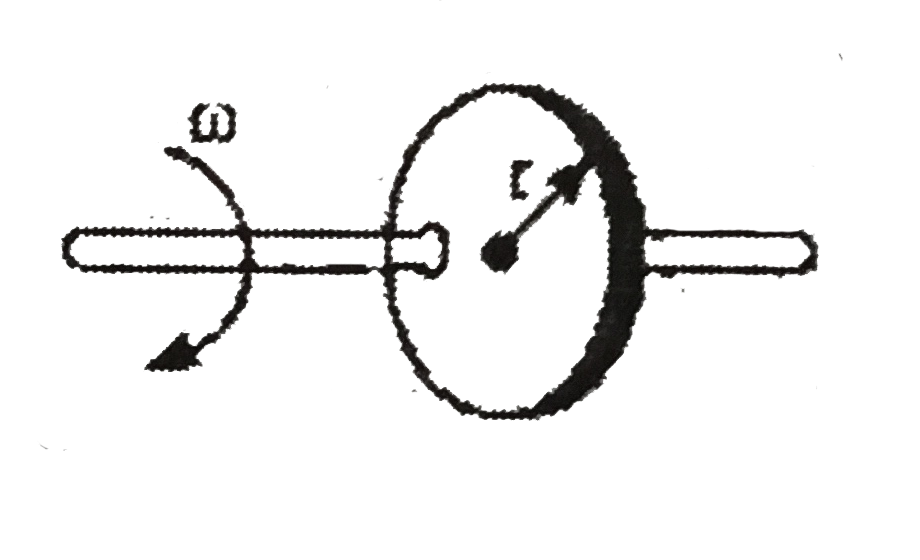A solid cube of side l is made to oscillate about a horizontal axis passing through one of its edges. Its time period will be
2π√2√23lg
2π√23lg
2π√√32lg
2π√2√3lg
The correct Answer is:A
To find the time period of oscillation of a solid cube of side l about a horizontal axis passing through one of its edges, we can follow these steps:
Step 1: Understand the Setup
We have a solid cube with side length l oscillating about a horizontal axis that passes through one of its edges. The center of mass of the cube is located at its geometric center.
Step 2: Identify Forces and Torque
When the cube is displaced by a small angle θ, the weight mg acts vertically downward. The component of the weight acting parallel to the direction of displacement is mgsinθ, which provides the torque necessary for oscillation.
Step 3: Calculate the Torque
The torque τ about the axis of rotation (which is at the edge of the cube) due to the weight of the cube is given by:
τ=mgsinθ⋅d
where d is the perpendicular distance from the line of action of the weight to the axis of rotation. For a cube, this distance can be calculated as:
d=l√2
Thus, the torque becomes:
τ=mgsinθ⋅l√2
Step 4: Moment of Inertia
Next, we need to calculate the moment of inertia I of the cube about the axis of rotation. The moment of inertia of a solid cube about an axis through its center of mass (perpendicular to one of its faces) is:
Icm=ml26
Using the parallel axis theorem, the moment of inertia about the edge is:
I=Icm+m(l√2)2=ml26+m⋅l22=ml26+3ml26=2ml23
Step 5: Relate Torque and Angular Acceleration
According to Newton's second law for rotation:
τ=Iα
Substituting the expressions for torque and moment of inertia:
mgsinθ⋅l√2=2ml23α
Step 6: Small Angle Approximation
For small angles, we can use the approximation sinθ≈θ:
mgθ⋅l√2=2ml23α
Step 7: Express Angular Acceleration
The angular acceleration α can be expressed as:
α=d2θdt2
Substituting this into the equation gives:
mgθ⋅l√2=2ml23d2θdt2
Step 8: Rearranging the Equation
Rearranging the equation leads to:
d2θdt2+3g2l/√2θ=0
This is a standard form of a simple harmonic motion equation, where the term 3g2l/√2 is the angular frequency squared ω2.
Step 9: Finding the Time Period
The angular frequency ω is related to the time period T by:
ω=2πT
Thus,
2πT=√3g2l/√2
Squaring both sides gives:
(2πT)2=3g√22l
Rearranging for T:
T=2π√2l3g
Final Answer
The time period of oscillation T is:
T=2π√2l3g
We have a solid cube with side length l oscillating about a horizontal axis that passes through one of its edges. The center of mass of the cube is located at its geometric center.
When the cube is displaced by a small angle θ, the weight mg acts vertically downward. The component of the weight acting parallel to the direction of displacement is mgsinθ, which provides the torque necessary for oscillation.
The torque τ about the axis of rotation (which is at the edge of the cube) due to the weight of the cube is given by:
τ=mgsinθ⋅d
where d is the perpendicular distance from the line of action of the weight to the axis of rotation. For a cube, this distance can be calculated as:
d=l√2
Thus, the torque becomes:
τ=mgsinθ⋅l√2
Next, we need to calculate the moment of inertia I of the cube about the axis of rotation. The moment of inertia of a solid cube about an axis through its center of mass (perpendicular to one of its faces) is:
Icm=ml26
Using the parallel axis theorem, the moment of inertia about the edge is:
I=Icm+m(l√2)2=ml26+m⋅l22=ml26+3ml26=2ml23
According to Newton's second law for rotation:
τ=Iα
Substituting the expressions for torque and moment of inertia:
mgsinθ⋅l√2=2ml23α
For small angles, we can use the approximation sinθ≈θ:
mgθ⋅l√2=2ml23α
The angular acceleration α can be expressed as:
α=d2θdt2
Substituting this into the equation gives:
mgθ⋅l√2=2ml23d2θdt2
Rearranging the equation leads to:
d2θdt2+3g2l/√2θ=0
This is a standard form of a simple harmonic motion equation, where the term 3g2l/√2 is the angular frequency squared ω2.
The angular frequency ω is related to the time period T by:
ω=2πT
Thus,
2πT=√3g2l/√2
Squaring both sides gives:
(2πT)2=3g√22l
Rearranging for T:
T=2π√2l3g
The time period of oscillation T is:
T=2π√2l3g
Topper's Solved these Questions
- ROTATIONAL MOTIONBOOK - ERRORLESS CHAPTER - ROTATIONAL MOTIONEXERCISE - Practice Problems (Problems based on rolling on incline plane)
28 Videos
- NEWTONS LAWS OF MOTIONBOOK - ERRORLESS CHAPTER - NEWTONS LAWS OF MOTIONEXERCISE - Self Evaluation Test
16 Videos
- SIMPLE HARMONIC MOTIONBOOK - ERRORLESS CHAPTER - SIMPLE HARMONIC MOTIONEXERCISE - simple Harmonic Motion
21 Videos
Similar Questions
Knowledge Check
A disc is made to oscillate about a horizontal axis passing through mid point of its radius. Determine time period.
A2π√3R2gB2π√2R3gC2π√RgD2π√2RgA metre scale is suspended vertically from a horizontal axis passing through one end of it. Its time period would be
A1.64 secB2 secC2.5 secD3.2 secA rod with rectangular cross section oscillates about a horizontal axis passing through one of its ends and it behaves like a seconds pendulum, its length will be
A1.5mB1mC3mD2m
A sphere is made to oscillate about a horizontal tangential axis. Determine time period.
View SolutionA thin uniform rod of lenth 120cm is made to oscillate about an axis passing through it end. Find the period and other points about which it has the same time period (g=9.8ms−2).
View SolutionThe moment of inertia of a cube of mass M and edge length a about an axis passing through one of its edge is
View SolutionA uniform disc of mass M and radius R is pivoted about a horizontal axis passing through its edge. It is released from rest with its centre of mass at the same height as the pivot.

View SolutionA thin uniform copper rod of length l and cross-section area A and mass m rotates uniformly with an angular velocity ω in a horizontal plane about a vertical axis passing through one of its ends. The elongation of the rod will be
View Solution
